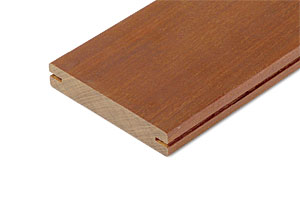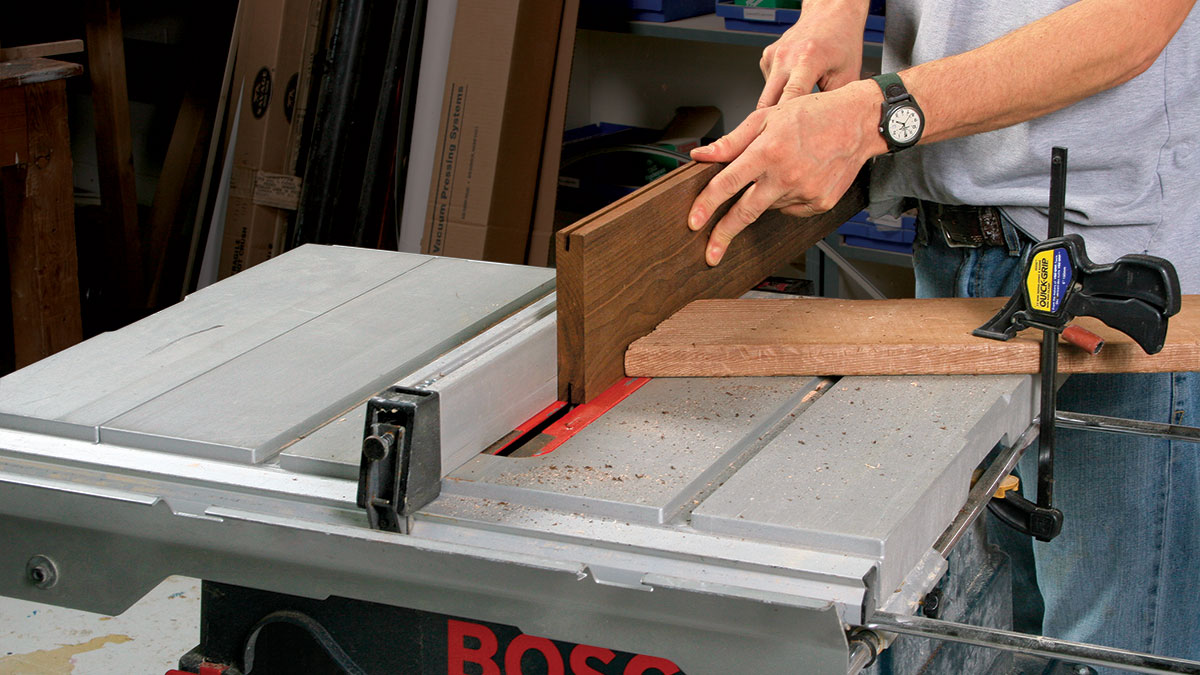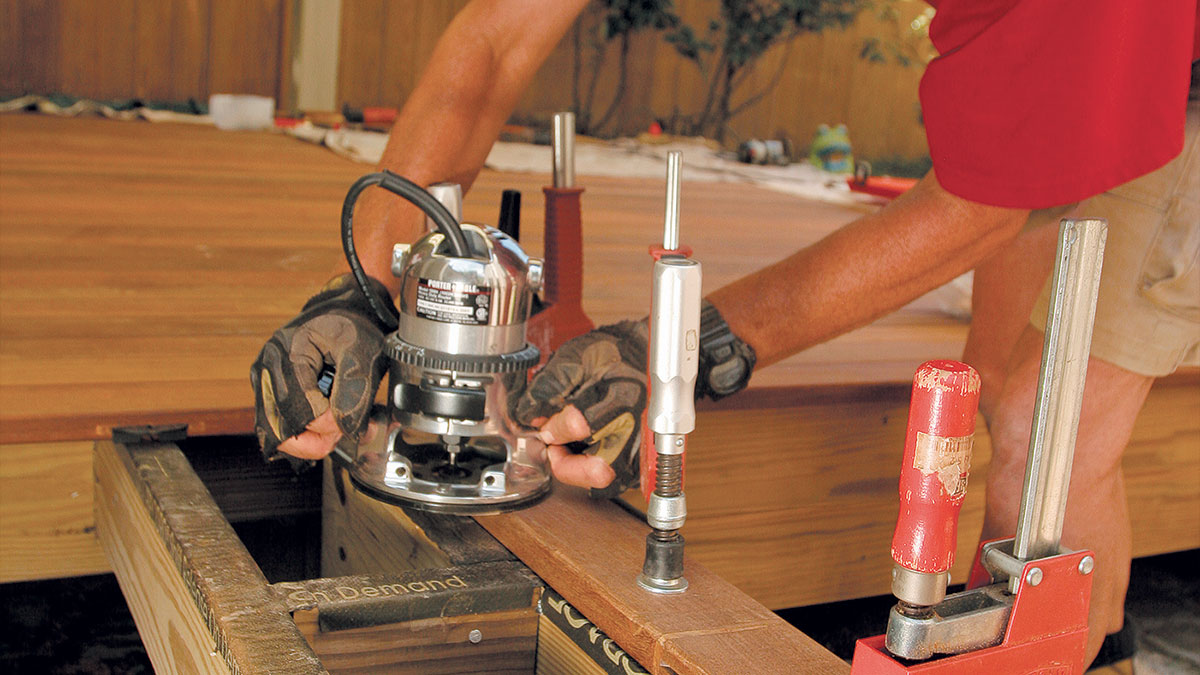Fasteners for Grooved Decking
Grooved boards and hidden fasteners combine for a blemish-free surface.

Whether you’re installing softwood, tropical hardwood, or choice synthetic decking, your project will look a lot better if you can’t see the fasteners. Less than 10 years ago, we had only a handful of concealed-fastener options, but now there are a half-dozen different categories of hidden fasteners—including rail/track systems, screw-on fasteners, drive-on/pin-style systems, and many more— and dozens of models within each category. Of the different options, grooved-decking fasteners have the widest variety and seem to be the most popular.
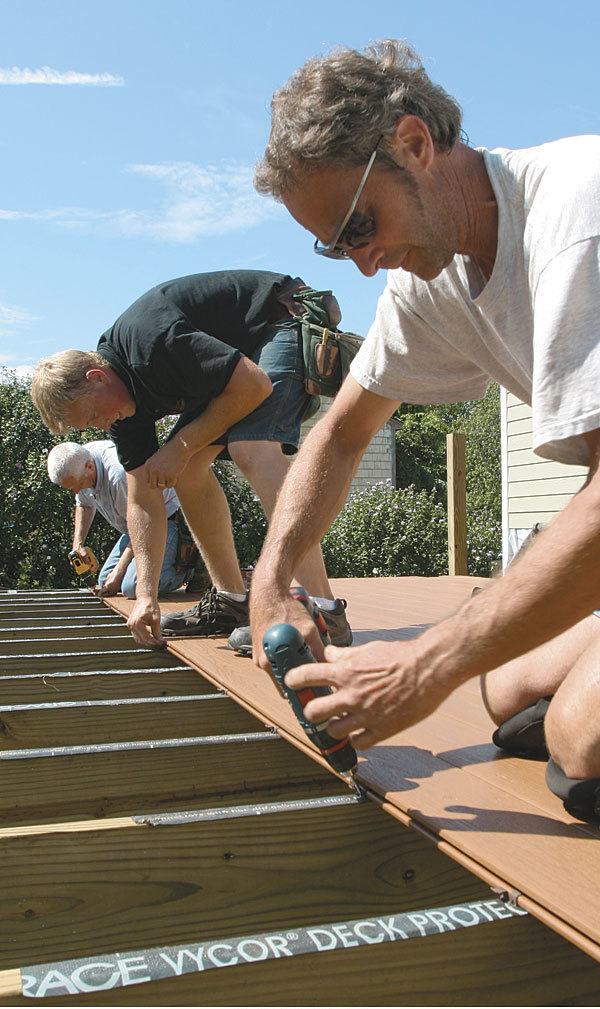 It’s all in the groove
It’s all in the groove

Grooved-decking fasteners engage slots along the boards’ edge. Nearly every synthetic deck-board manufacturer offers grooved decking. A few years ago, dealer stock was predominantly square-edge decking, but there’s been a significant shift toward grooved boards. This isn’t so much the case with home centers, but it’s probably just a matter of time.
Even some types of premium wood decking come grooved from the mill or wholesaler, or they can be grooved at the lumberyard for a nominal fee. If you’re feeling ambitious or have just a small job, you also can slot the deck boards yourself with a router, a biscuit joiner, or a tablesaw.
The trend toward more grooved boards in the market drives many people to reach for grooved-decking fasteners as well—and there are more than 30 fastener models from 10 different companies to choose from. So even if your decking supplier stocks only one model, you can get any of the others either through web-based retailers or through a regional distributor who supplies the local lumberyard. Most of the manufacturers’ websites will direct you to those sellers or distributors.
There are several factors to consider when deciding which grooved-decking fastener will work best for your project: ease of installation, installation speed, appearance, type of decking, size and complexity of the deck, fastener cost, and compatibility with the decking. In most cases, though, it comes down to plainold personal preference, which comes only after trying a variety of hidden-fastener systems. I’ve been lucky enough to try all these systems, so I can offer some real-world information to help get you started.
Biscuits and clips
There are two basic categories of grooved-decking fasteners: biscuit or T-shaped, and clip style. Biscuit-style fasteners come in a variety of shapes and sizes, and most are made from plastic or metal-reinforced plastic. The top of the “T” fits inside the grooves of the deck boards. Clip-style fasteners are all metal and have blades or tabs formed into the design that engage the groove. Most fasteners from both groups automatically space the decking either with bottom legs of different widths or dedicated spacers built into the body.
With so many brands, types, and sizes available, matching a hidden fastener to your decking can be daunting. Not every board has a groove of the same width, depth, and height, so you have to sort through the fastener options to find the right fit. Some decking brands prohibit edge-slotting altogether, so you have to use a screw-on or drive-on fastening system. Other boards aren’t compatible with undermount and screw-on systems due to the decking crosssection design or density.
Luckily, many manufacturers make fastener recommendations. Also, to simplify the decision, many deck-board manufacturers now offer fasteners, too.
Deck mates
Many synthetic- and even some premium-wood-decking suppliers have partnered recently with hidden-deck-fastener makers. In some cases, they are designing special fasteners suited specifically to their products; in others, they’re simply putting private labels on existing fastener designs. There are advantages to using decking-branded fasteners— you know they will fit and have been tested by the decking company for performance—but aside from Fiberon and CertainTeed, you aren’t locked into using them exclusively to preserve the warranty.
Many decking companies recommend screws and hidden fasteners in their installation instructions. These recommendations are offered as just that—recommendations, not requirements. You can still use another fastening system provided it’s compatible with your planks.
When first trying a decking and hidden-fastener combination that falls outside the branded or recommended categories, ask the makers of the decking and the hidden-fastening system about compatibility. In many cases, the companies either will have worked together to check compatibility or have tested each other’s products.
Automatic speed
In less than three years, hidden deck fastening has gone from hand installation to semiautomatic clip installation, as with the Eliminator system shown above (www.panamericanscrew.com). Now we’re seeing prototypes of fully automated installation systems in which grooved-board fasteners and pneumatically driven screws are fed to the nose of a nailer. These systems speed installation by two to three times and are a must-have for pro deck builders. Even if you lay decking only occasionally, check with your decking supplier; many offer rental or loaner tools.
EB-TY
www.ebty.comPrice: $1.95 to $1.82
EB-TY makes eight different-size, biscuit-shaped, black polypropylene fasteners. The main difference between models is the height and width of the spacer legs. The height of the leg on regular models works on decking that is 1 in. and thicker, and the short-leg models are for 11/16-in. and 3/4-in. decking. The different leg sizes gap the decking at 1/8 in., 3/32 in., 1/4 in., or 3/16 in. Although some are fastened with screws driven straight down, most EB-TY models have oblong holes in the top so that you can drive screws diagonally through the bottom edge of the deck plank. The diagonal screw attaches both the EB-TY fastener and the leading edge of the decking to the frame.
A couple of models also have hollow tubes formed into the leg—the company calls them “Live Cylinders”— designed to absorb expansion and contraction. The shape of EB-TY fasteners matches standard biscuit-joiner mortises that you can custom-cut in the decking at each joist position.
Although not widely publicized, EB-TY fasteners also can be secured with 1/2-in.-crown stainless-steel staples. The staple legs drive right through the plastic fastener and into the joist.
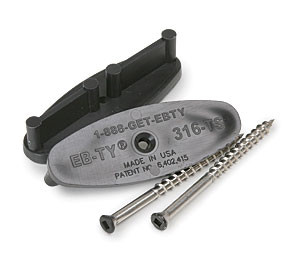 |
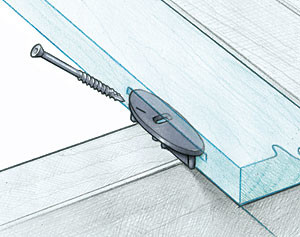 |
Ipe Clip
Price: $1.33 to $1.62
Despite the name, Ipe Clips can be used with a variety of dry wood, PVC, and wood-plastic-composite (WPC) decking. There are four different models that come in three colors (black, beige, and light gray) to help the fasteners disappear between deck boards. All models are screwed in at an angle so that the bottom edge of the deck board is secured. The standard clip is a round fiberglass-reinforced-plastic fastener with a 3⁄32-in. spacer fin. The Extreme, Extreme KD, and Extreme 4 models are the same material, but they are square and have a stainless-steel plate formed in the center for extra strength. The main difference between the three Extreme models is the joint spacing that each registers between deck boards, which ranges from 3⁄32 in. to 5⁄32 in.
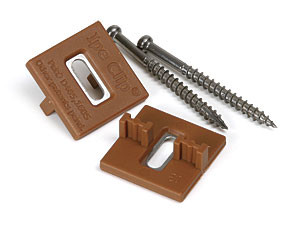 |
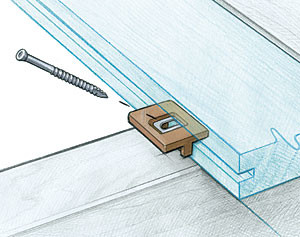 |
Mantis Clip
Price: 90¢
Ty-Lan Industries makes Mantis clips in two versions (models .345 and .396) that match the grooves on a variety of grooved deck boards. Each clip has a bottom plate that slides beneath the decking and receives a diagonally driven screw to hold it to the joist. The groove tabs have upturned ends to lock into the slots. The installed board receives the single centered tab, and the oncoming board mounts over two tabs.
The bottom plate elevates the decking off the joists by 1/16 in. and helps to dry any water that collects in the laps. Angle brackets are available for installing starter boards, end boards, fascias, and stair risers. These clips can be installed by hand or with the Eliminator tool and pneumatically driven screws.
 |
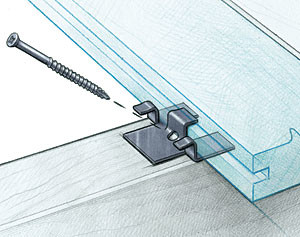 |
Tiger Claw
Price: $1.06 to $1.20
Tiger Claw has two models, the TC-G (aka TC-150) for 1-in.-thick decking and the TC-120 for 3/4-in.-thick boards. Both models are stainless steel with a black-oxide coating. The clips have opposing offset tabs with teeth that engage the decking groove and screw diagonally down into the joists.
Tiger Claw also has the Butt Seam Clip, which is a mirror image of the TC-G. When a TC-G and a Butt Seam Clip are positioned side by side on a joist at a decking joint, each fastener locks into the end of one deck board.
Tiger Claw clips can be installed by hand, or with a purpose-made pneumatic nailer.
Fasco/Beck’s (www.beck-fastening.com) InvisiDeck I-CLP clips are identical to Tiger Claw TC-G fasteners.
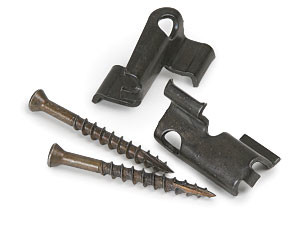 |
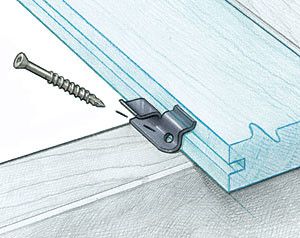 |
The Deck Clip
Price: $1.14
Wood Haven Inc. makes The Deck Clip. It’s a small marine-grade aluminum fastener with two layers of Magni-599 corrosion-resistant coating. The Deck Clip has a short T-leg and works best on 11/16-in.- to 1-in.-thick decking. The mounting screws drive straight down into joists. Look closely at the profile to see the slightly lobed ends on the groove flanges that help to grip the decking. The Deck Clip can be used on custom-grooved hardwood decking and many factory-grooved synthetic-decking brands.
 |
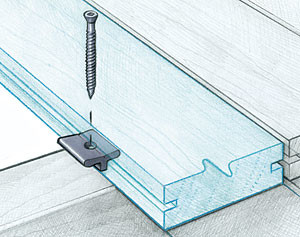 |
DeckEase
Price: 77¢
Instead of screwing into the top of the joist, the DeckEase screws into the side. Because it doesn’t register the groove-tab level off the top of the joist, this one-size fastener fits any height slot and any thickness of decking. The DeckEase fits 1/8-in.- to 3/16-in.-wide slots. One side of the fastener leg has tiny points that you drive into the side of the joist after engaging one groove tab with the decking. The points hold the DeckEase in position until you drive the screw into the side of the joist. Fasteners can be installed on the left or right side of the joist, or they can be doubled up on both sides of a joist where decking butt joints land. The clips don’t automatically register a joint space, but you can gap any distance you like from 1/8 in. to 5/16 in.
 |
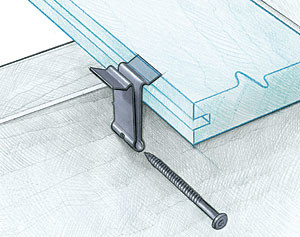 |
Quick-Fire System
[Editor’s Note: This system is no longer available]
Price: 73¢
The Wadsworth Company’s deck clips aren’t widely known, but their Quick-Fire system is unique. The small, stainless-steel-capped plastic fasteners are collated into strips and are loaded with stainless-steel screws to simplify fastener handling. Rather than reaching into your pouch for each fastener or juggling several in hand, you can hold a string of 13 Wadsworths ready for mounting.
To use, you align the strip of fasteners with the grooved deck board, drive the screw in the last fastener straight down into the joist, then pull to snap off the remaining clip strip. It takes several tries to develop the knack for snapping off the end clip and not a clip farther down the string.
There are three models: The QF100 and QFP100 are sized for 1-in.-thick decking and register 3/16-in. spacing; the only difference is that the stainless-steel cap plate on the QFP100 has downturned corners to grip the board groove tightly. The QF75 has a shorter T-leg for 3/4-in.-thick decking.
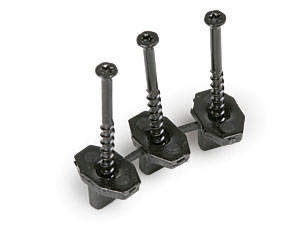 |
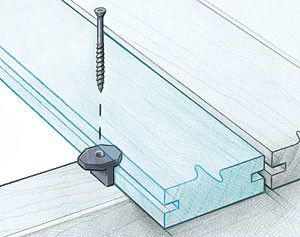 |
Invisi-Fast
Price: 86¢ to 91¢
Four of the five Invisi-Fast Biscuit models are made of clear, paintable polycarbonate plastic, which is much stiffer than the polyethylene plastic used in some other fasteners.
Each rectangular-shaped fastener is screwed straight down into the joists. The NM model works on a variety of grooved deck boards and registers a 3/16-in. space. The TD model is sized for TigerDeck hardwood decking; the TT model is designed for TimberTech decking; the TQ model works on 3/4-in. deck boards with a 1/8-in. groove; and the TXB model is made of black colored plastic and is designed specifically for Trex grooved deck boards.
 |
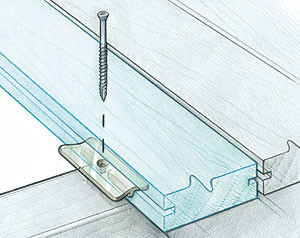 |
Grabber
[Editor’s Note: This system is no longer available]
Price: $1.04
Grabber has three metal clip models, all made of steel covered with a proprietary coating that is suitable for all locations except coastal areas. The G5 is the flagship model and fits a variety of grooved deck boards, spacing them 13/64 in. apart. The GTT5 is sized specifically for TimberTech. A third model, the GW5, is unique. It has extradeep groove tabs for use on wet softwood decking and wet pressure-treated decking that is expected to shrink after installation. Deck boards installed with the GW5 need to be slotted with the PowerBlade, a special router bit that cuts the extradeep recess and undercuts the decking edge beneath the slot. This permits the deck boards to be installed tightly together in anticipation of shrinkage, and the long tabs hold in the groove even after shrinkage.
The Grabber fasteners can be installed by hand or by using Grabber’s PowerDriver installation nailer and pneumatically driven screws.
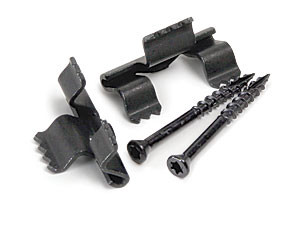 |
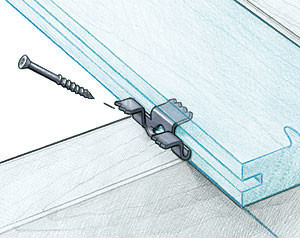 |
Lumber Loc
[Editor’s Note: This system has been replaced by EbTy]
Price: 90¢
Lumber Loc fasteners are black, rectangular polypropylene biscuits that screw straight down into the joists rather than diagonally. The rectangular design has the greatest edge contact with the decking groove. Each clip has Y-shaped tabs at each end to gauge deck-board spacing, and the tabs compress under pressure to hold the planks while still allowing for expansion without buckling. The tabs stand proud of the fastener surface and come close to the face of 3/4-in. and thinner decking material. The single size fits many brands of grooved deck boards as well as custom-biscuited or custom-grooved wood deck boards.
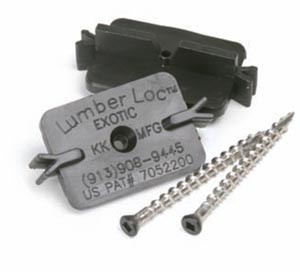 |
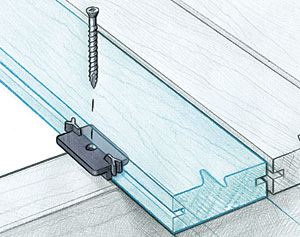 |
Three Ways to Slot a Board on Site
Not every building-material dealer stocks grooved wood-plastic-composite (WPC) deck boards—not yet at least—and most softwood and hardwood planks still aren’t grooved unless you request it. If you want to use any of the grooved deck-board fastening systems, you may have to slot the boards yourself. There are several ways to groove deck boards on site. The key is in the setup. You need the slot to be the right width and depth, at the right height off the deck joists, and spaced consistently along the length of the plank.
Biscuit-Joiner Slots
Several of the original hidden-decking-fastener instructions called for biscuit slots to be cut into the decking at each joist position. Although the practice isn’t as popular as it used to be, it is still viable.
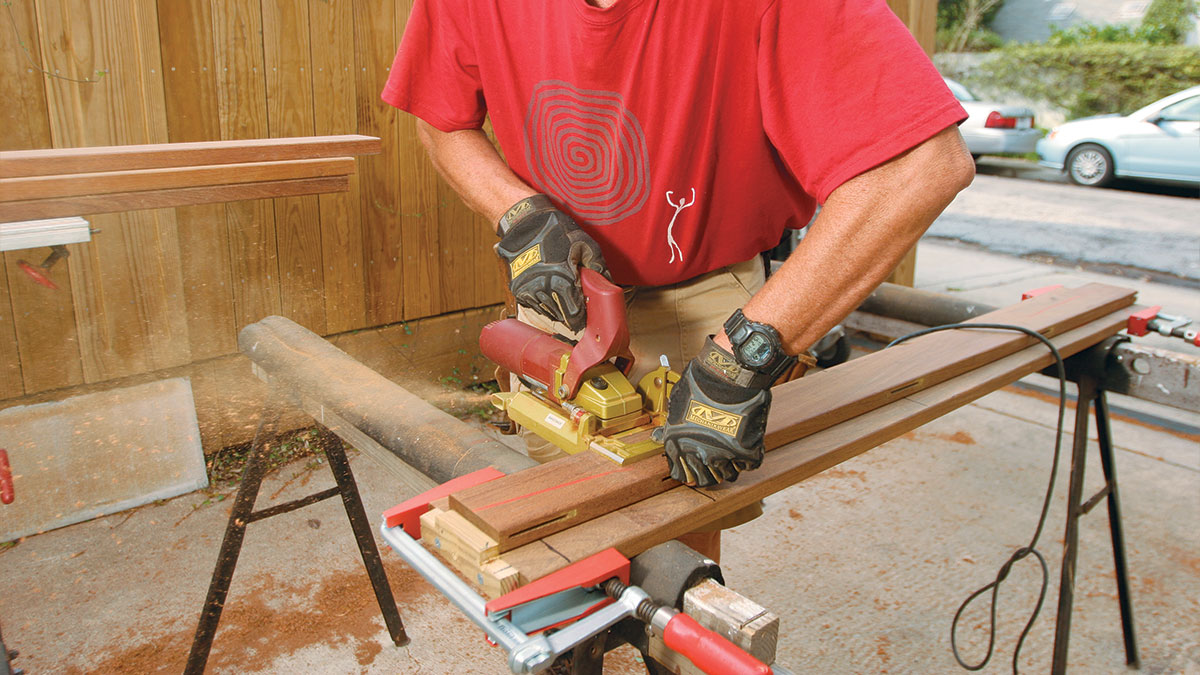
Use a scrap piece of decking to make practice and adjustment slots until you have the correct slot level for the fasteners. You can either mark each deck board for slotting on both sides or lie the decking across the frame and eye the joists to orient the joiner. I speed production by laying out a series of deck boards across the joists and snap white chalklines centered on each joist. Then I biscuit-slot a batch of decking all at once.
One benefit to biscuit cutting is that you slot the plank only at the joist and not the entire length. This appeals to some users because there’s less grooved area where water and debris can collect. And for people who find the groove between joists an eyesore, biscuit slots may be a reasonable compromise. On the downside, biscuit cutting can be time-consuming compared to fully grooving the planks production-style.
Sawkerfs on the Tablesaw
Many carbide-tooth sawblades cut 1/8-in.- to 3/16-in.-wide kerfs, which match many grooved-board fasteners.
The best way to run decking through the blade is with the bottom side facing the fence. This ensures that the height off the joists to the kerf will be uniform and will match the grooved-board hidden fastener you’ll be using. The blade depth should be set no more than 1/8 in. deeper than the hidden-fastener flange is wide. Overcutting the groove depth increases the chance wood decking will split at the bottom of the kerf.
Use a featherboard to keep the decking snug against the fence and to help to resist kickback. Although it’s not shown here, a tall subfence can be used to attach another featherboard above the deck board to keep it tight to the table. Make sure to use infeed and outfeed tables or rollers to manage long deck boards.
Bump-Slotting with a Router
Slot cutting with a router bit can be done right on top of the deck joists or with the planks laid across several sawhorses. Several grooved-board fastener companies sell bottom- or top-bearing slot cutters that match their products. These cutters slot the right width and depth; the only thing you have to do is make sure the height of the cut matches the level from the deck joist to the slot. It’s always good to practice on a scrap piece of decking.
One thing to watch out for: The corners on some deck boards are rounded over enough to interfere with the position of the bearing on the router bit. This can cause the baseplate to lift off the decking. Again, practice on a scrap piece first.
Router cutters also can be used to “bump-slot” the decking (as shown here) rather than rout a slot along the entire board. Bump-slotting cuts a short, biscuit-shaped groove similar to that made by a biscuit joiner. It’s easiest to bump-slot with the decking laid across the joists. You draw the router bit into the decking while using the joists as a visual cue. It takes practice to make the cuts quickly without losing control and having the router buck or cut an oversize slot.
Photos: Jean-Paul Vellotti unless otherwise noted.
Drawings: Bob LaPointe

Fine Homebuilding Recommended Products
Fine Homebuilding receives a commission for items purchased through links on this site, including Amazon Associates and other affiliate advertising programs.
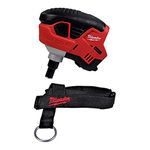
Lithium-Ion Cordless Palm Nailer
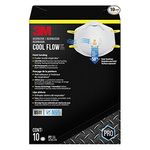
N95 Respirator
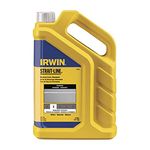
Standard Marking Chalk

